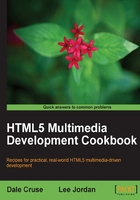
Displaying multiple sidebars using the aside tag
"The
<aside>element represents a section of a page that consists of content that is tangentially related to the content around the<aside>element, and which could be considered separate from that content." - WHATWG's HTML5 Draft Standard - http://whatwg.org/html5
Getting ready
It seems like every blog and many other types of websites have sidebars filled with all sorts of information. Here, we're going to add an additional sidebar to Roxane's single-page portfolio site using the new <aside> tag.
How to do it...
Roxane wants to let people know where else she can be reached, and so do you. Let's use the <aside> tag to create a sidebar and draw attention to her web presence:
<!DOCTYPE html> <html lang="en"> <head> <meta charset="UTF-8"> <title>Roxane</title> <!--[if lt IE 9]><script src="http://html5shiv.googlecode.com/svn/trunk/html5.js"> </script>[endif]--> <meta name="viewport" content="width=device-width, initial-scale=1.0"> </head> <body> <header> <hgroup> <h1>Roxane is my name.</h1> <h2>Developing websites is my game.</h2> </hgroup> </header> <nav> <ul> <li><a href="#About">About</a></li> <li><a href="#Work">Work</a></li> <li><a href="#Contact">Contact</a></li> </ul> </nav> <section id="About"> <h3>About</h3> <p>I'm a front-end developer who's really passionate about making ideas into simply dashing websites.</p> <p>I love practical, clean design, web standards give me joyful chills, and good usability tickles the butterflies in my stomach.</p> </section> <section id="Work"> <h3>Work</h3> <p>sample 1</p> <p>sample 2</p> <p>sample 3</p> </section> <section id="Contact"> <h3>Contact</h3> <p>email</p> <p>phone</p> <p>address</p> </section> <aside> <h4>What I'm Reading</h4> <ul> <li><img src="http://packtpub.com/sites/default/files/imagecache/ uc_thumbnail/2688OS_MockupCover.jpg" alt="Inkscape 0.48 Essentials for Web Designers"> Inkscape 0.48 Essentials for Web Designers</li> <li><img src="http://packtpub.com/sites/default/files/imagecache/ uc_thumbnail/bookimages/0042_MockupCover_0.jpg" alt="jQuery 1.4 Reference Guide"> jQuery 1.4 Reference Guide</li> <li><img src="http://packtpub.com/sites/default/files/imagecache/ uc_thumbnail/9881OS_MockupCover.jpg" alt="Blender 2.5 Lighting and Rendering"> Blender 2.5 Lighting and Rendering</li> </ul> </aside> <aside> <h4>Elsewhere</h4> <p>You can also find me at:</p> <ul> <li><a href="http://linkedin.com/in/">LinkedIn</a></li> <li><a href="http://twitter.com/">Twitter</a></li> <li><a href="http://facebook.com/">Facebook</a></li> </ul> </aside> </body> </html>
How it works...
Building on the success we had previously with the <aside> tag, we've used it again to align information that is subsequent to the main information.
There's more...
Just because a design calls for a sidebar, don't automatically reach for the <aside> tag. Carefully consider your content before considering position.
See also
Together, Bruce Lawson and Remy Sharp penned the outstanding Introducing HTML5 reference available at: http://peachpit.com/store/product.aspx?isbn=0321687299